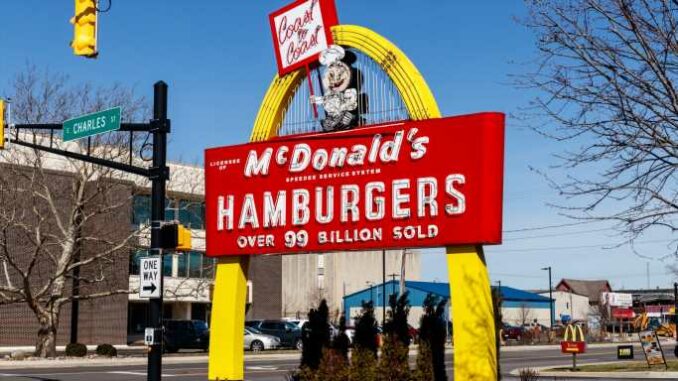
The Big Mac — the menu mainstay of McDonald’s, one of America’s largest fast-food chains — is among the most famous sandwiches in the United States. The ingredients of the burger were enshrined in a television commercial jingle: Two all-beef patties, special sauce, lettuce, cheese, pickles, onions on a sesame seed bun. (These are the top 5 McDonald’s menu items in every state.)
The sandwich is so well known that the Economist magazine publishes The Big Mac Index, which uses Big Mac prices to approximate cost of living, or purchasing power, in countries around the world. When it debuted in 1967, the Big Mac cost 45 cents; today, the average price is $5.17. These days, the price of the sandwich in the U.S. varies considerably from state to state.
To identify the “true cost” of a Big Mac in each state, 24/7 Wall St. adjusted the average Big Mac price in each state by the state’s disposable income per capita (income after taxes) and cost of living (based on regional price parities). In other words, considering income, taxes, cost and living and actual Big Mac price in each state — we calculated the true cost of Big Mac for residents living in that state. The 50 states were ranked by the “true cost” of a Big Mac.
The Big Mac is supposed to taste the same regardless of where you are, but the price varies dramatically. Prices in each state range from $4.19 to $7.09, while the “true cost” of a Big Mac — after adjusting for income, taxes, and cost of living — ranges from $3.44 to $6.54. The true cost of a Big Mac is highest in the East Coast states of Maine, Rhode Island, Massachusetts, and Vermont, as well as the Southern states of Arkansas and Mississippi, two of the poorer states in the Union. (These are the 31 poorest states in America ranked.)
Folks in Wyoming and South Dakota get the best deal for the iconic burger. In Wyoming, the true cost is $3.44 and the actual price is $4.19, 19% lower than the national average price. This is because disposable income in the state is $62,227, 11.5% higher than the national average, while the cost of living is 8.6% lower than national average. Similarly, in South Dakota, the true cost of a Big Mac is $3.83 and the actual price is $4.54, 12.2% lower than national average. Disposable income in South Dakota is $59,688, 6.9% higher than the national average, while the cost of living is 9.9% lower than the national average.
On the other hand, in Vermont, where the price of a Big Mac is $6.29, or 21.7% higher than the national average, after considering the state’s relatively low disposable income of $54,714 (2.0% lower than national average) and cost of living that is just 1.3% lower than the national average, the true cost of a Big Mac comes to $6.33. Similarly in Hawaii, where the price of a Big Mac is $5.31, after considering the state’s relatively low disposable income of $52,515 (5.9% lower than national average) and the nation’s highest cost of living, the true cost of a Big Mac for residents there comes to $6.39.
Click here to see the states where people can’t afford a Big Mac.
Click here to read our detailed methodology.
Sponsored: Tips for Investing
A financial advisor can help you understand the advantages and disadvantages of investment properties. Finding a qualified financial advisor doesn’t have to be hard. SmartAsset’s free tool matches you with up to three financial advisors who serve your area, and you can interview your advisor matches at no cost to decide which one is right for you. If you’re ready to find an advisor who can help you achieve your financial goals, get started now.
Investing in real estate can diversify your portfolio. But expanding your horizons may add additional costs. If you’re an investor looking to minimize expenses, consider checking out online brokerages. They often offer low investment fees, helping you maximize your profit.
Source: Read Full Article